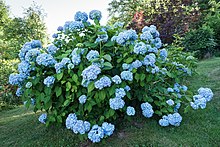Shrub
This article needs additional citations for verification. (October 2018) |
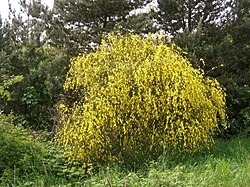
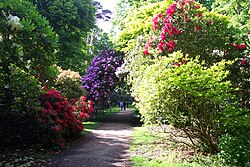
A shrub (often called a bush) is a small- to medium-sized perennial woody plant. Unlike herbaceous plants, shrubs have persistent woody stems above the ground. Shrubs can be deciduous or evergreen. They are distinguished from trees by their multiple stems and shorter height, less than 6–10 m (20–33 ft) tall.[1][2] Small shrubs, less than 2 m (6.6 ft) tall are sometimes termed subshrubs.
Definition[]
Shrubs are perennial woody plants, and therefore have persistent woody stems above ground (compare with herbaceous plants).[2] Usually shrubs are distinguished from trees by their height and multiple stems. Some shrubs are deciduous (e.g. hawthorn) and others evergreen (e.g. holly).[2] Ancient Greek philosopher Theophrastus divided the plant world into trees, shrubs and herbs.[3]
Height[]
Some definitions state that a shrub is less than 6 m (20 ft) and tree is over 6 m. Others use 10 m (33 ft) as the cut-off point.[2] Many species of tree may not reach this mature height because of less than ideal growing conditions, and resemble a shrub-sized plant. However such species have the potential to grow taller under the ideal growing conditions for that plant.
Small, low shrubs, generally less than 2 m (6.6 ft) tall, such as lavender, periwinkle and most small garden varieties of rose, are often termed subshrubs.[4]
Multiple stems[]
Most definitions characterize shrubs as possessing multiple stems with no main trunk.[2] This is because the stems have branched below ground level. There are exceptions to this, with some shrubs having main trunks, but these tend to be very short and divide into multiple stems close to ground level. Many trees can grow in multiple stemmed forms also, such as oak or ash.[2][clarification needed]
Use in parks[]

An area of cultivated shrubs in a park or a garden is known as a shrubbery.[5] When clipped as topiary, suitable species or varieties of shrubs develop dense foliage and many small leafy branches growing close together.[6] Many shrubs respond well to renewal pruning, in which hard cutting back to a "stool" results in long new stems known as "canes".[clarification needed] Other shrubs respond better to selective pruning to reveal their structure and character.
Shrubs in common garden practice are generally considered broad-leaved plants, though some smaller conifers such as mountain pine and common juniper are also shrubby in structure. Species that grow into a shrubby habit may be either deciduous or evergreen.[7]
Botanical structure[]
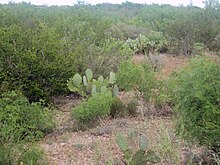

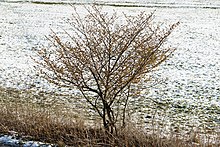

In botany and ecology, a shrub is more specifically used to describe the particular physical structural or plant life-form of woody plants which are less than 8 metres (26 ft) high and usually have many stems arising at or near the base.[clarification needed] For example, a descriptive system widely adopted in Australia is based on structural characteristics based on life-form, plus the height and amount of foliage cover of the tallest layer or dominant species.[8]
For shrubs 2–8 metres (6.6–26.2 ft) high the following structural forms are categorized:
- dense foliage cover (70–100%) — closed-shrub
- mid-dense foliage cover (30–70%) — open-shrub
- sparse foliage cover (10–30%) — tall shrubland
- very sparse foliage cover (<10%) — tall open shrubland
For shrubs less than 2 metres (6.6 ft) high the following structural forms are categorized:
- dense foliage cover (70–100%) — closed-heath or closed low shrubland—(North America)
- mid-dense foliage cover (30–70%) — open-heath or mid-dense low shrubland—(North America)
- sparse foliage cover (10–30%) — low shrubland
- very sparse foliage cover (<10%) — low open shrubland
List of shrubs[]
Those marked with * can also develop into tree form.
- A
- Abelia (Abelia)
- Acer (Maple) *
- Actinidia (Actinidia)
- Aloe (Aloe)
- Aralia (Angelica Tree, Hercules' Club) *
- Arctostaphylos (Bearberry, Manzanita) *
- Aronia (Chokeberry)
- Artemisia (Sagebrush)
- Aucuba (Aucuba)
- B
- Berberis (Barberry)
- Bougainvillea (Bougainvillea)
- Brugmansia (Angel's trumpet)
- Buddleja (Butterfly bush)
- Buxus (Box) *
- C
- Calia (Mescalbean)
- Callicarpa (Beautyberry) *
- Callistemon (Bottlebrush) *
- Calluna (Heather)
- Calycanthus (Sweetshrub)
- Camellia (Camellia, Tea) *
- Caragana () *
- Carpenteria (Carpenteria)
- Caryopteris ()
- Cassiope ()
- Ceanothus (Ceanothus) *
- Celastrus (Staff vine) *
- Ceratostigma ()
- Cercocarpus (Mountain-mahogany) *
- Chaenomeles (Japanese Quince)
- Chamaebatiaria (Fernbush)
- Chamaedaphne (Leatherleaf)
- Chimonanthus (Wintersweet)
- Chionanthus (Fringe-tree) *
- Choisya (Mexican-orange Blossom) *
- Cistus (Rockrose)
- Clerodendrum (Clerodendrum)
- Clethra (Summersweet, Pepperbush) *
- Clianthus ()
- Colletia (Colletia)
- Colutea (Bladder Senna)
- Comptonia (Sweetfern)
- Cornus (Dogwood) *
- Corylopsis (Winter-hazel) *
- Cotinus (Smoketree) *
- Cotoneaster (Cotoneaster) *
- Cowania (Cliffrose)
- Crataegus (Hawthorn) *
- Crinodendron (Crinodendron) *
- Cytisus and allied genera (Broom) *
- D
- Daboecia (Heath)
- Danae (Alexandrian laurel)
- Daphne (Daphne)
- Decaisnea (Decaisnea)
- Dasiphora (Shrubby Cinquefoil)
- Dendromecon (Tree poppy)
- Desfontainea (Desfontainea)
- Deutzia (Deutzia)
- Diervilla (Bush honeysuckle)
- Dipelta (Dipelta)
- Dirca (Leatherwood)
- Dracaena (Dragon tree) *
- Drimys (Winter's Bark) *
- Dryas (Mountain Avens)
- E
- Edgeworthia (Paper Bush) *
- Elaeagnus (Elaeagnus) *
- Embothrium (Chilean Firebush) *
- Empetrum (Crowberry)
- Enkianthus ()
- Ephedra (Ephedra)
- Epigaea (Trailing Arbutus)
- Erica (Heath)
- Eriobotrya (Loquat) *
- Escallonia (Escallonia)
- Eucryphia (Eucryphia) *
- Euonymus (Spindle) *
- Exochorda (Pearl Bush)
- F
- Fabiana (Fabiana)
- Fallugia (Apache Plume)
- Fatsia (Fatsia)
- Forsythia (Forsythia)
- Fothergilla (Fothergilla)
- Franklinia (Franklinia) *
- Fremontodendron (Flannelbush)
- Fuchsia (Fuchsia) *
- G
- Garrya (Silk-tassel) *
- Gaultheria (Salal)
- Gaylussacia (Huckleberry)
- Genista (Broom) *
- Gordonia (Loblolly-bay) *
- Grevillea (Grevillea)
- Griselinia (Griselinia) *
- H
- Hakea (Hakea) *
- Halesia (Silverbell) *
- Halimium (Rockrose)
- Hamamelis (Witch-hazel) *
- Hebe (Hebe)
- Hedera (Ivy)
- Helianthemum (Rockrose)
- Hibiscus (Hibiscus) *
- Hippophae (Sea-buckthorn) *
- Hoheria (Lacebark) *
- Holodiscus (Creambush)
- Hudsonia (Hudsonia)
- Hydrangea (Hydrangea)
- Hypericum (Rose of Sharon)
- Hyssopus (Hyssop)
- I
- J
- Jamesia (Cliffbush)
- Jasminum (Jasmine)
- Juniperus (Juniper) *
- K
- Kalmia (Mountain-laurel)
- Kerria (Kerria)
- Kolkwitzia (Beauty-bush)
- L
- Lagerstroemia (Crape-myrtle) *
- Lapageria (Copihue)
- Lantana (Lantana)
- Lavandula (Lavender)
- Lavatera (Tree Mallow)
- Ledum (Ledum)
- Leitneria (Corkwood) *
- Lespedeza (Bush Clover) *
- Leptospermum (Manuka) *
- Leucothoe (Doghobble)
- Leycesteria (Leycesteria)
- Ligustrum (Privet) *
- Lindera (Spicebush) *
- Linnaea (Twinflower)
- Lonicera (Honeysuckle)
- Lupinus (Tree Lupin)
- Lycium (Boxthorn)
- M
- Magnolia (Magnolia)
- Mahonia (Mahonia)
- Malpighia (Acerola)
- Menispermum (Moonseed)
- Menziesia (Menziesia)
- Mespilus (Medlar) *
- Microcachrys (Microcachrys)
- Myrica (Bayberry) *
- Myricaria (Myricaria)
- Myrtus and allied genera (Myrtle) *
- N
- O
- Olearia (Daisy bush) *
- Osmanthus (Osmanthus)
- P
- Pachysandra (Pachysandra)
- Paeonia (Tree-peony)
- Persoonia (Geebungs)
- Philadelphus (Mock orange) *
- Phlomis (Jerusalem Sage)
- Photinia (Photinia) *
- Physocarpus (Ninebark) *
- Pieris (Pieris)
- Pistacia (Pistachio, Mastic) *
- Pittosporum (Pittosporum) *
- Plumbago (Leadwort)
- Polygala (Milkwort)
- Poncirus *
- Prunus (Cherry) *
- Purshia (Antelope Bush)
- Pyracantha (Firethorn)
- Q
- R
- Rhamnus (Buckthorn) *
- Rhododendron (Rhododendron, Azalea) *
- Rhus (Sumac) *
- Ribes (Currant, Gooseberry)
- Romneya (Tree poppy)
- Rosa (Rose)
- Rosmarinus (Rosemary)
- Rubus (Bramble, Raspberry, Salmonberry, Wineberry)
- Ruta (Rue)
- S
- *
- Salix (Willow) *
- Salvia (Sage)
- Salvia subg. (Russian Sage)
- Sambucus (Elder) *
- Santolina ()
- Sapindus (Soapberry) *
- Senecio (Senecio)
- Simmondsia (Jojoba)
- Skimmia (Skimmia)
- Smilax (Smilax)
- Sophora (Kowhai) *
- Sorbaria (Sorbaria)
- Spartium (Spanish Broom)
- Spiraea (Spiraea) *
- Staphylea (Bladdernut) *
- Stephanandra (Stephanandra)
- Styrax *
- Symphoricarpos (Snowberry)
- Syringa (Lilac) *
- T
- Tamarix (Tamarix) *
- Taxus (Yew) *
- Telopea (Waratah) *
- Thuja cvs. (Arborvitae) *
- Thymelaea
- Thymus (Thyme)
- Trochodendron *
- U
- Ulex (Gorse)
- ()
- Ungnadia (Mexican Buckeye)
- V
- Vaccinium (Bilberry, Blueberry, Cranberry)
- Verbesina centroboyacana
- Verbena (Vervain)
- Viburnum (Viburnum) *
- Vinca (Periwinkle)
- Viscum (Mistletoe)
- W
- Weigela (Weigela)
- X
- Xanthoceras
- Xanthorhiza (Yellowroot)
- Xylosma
- Y
- Yucca (Yucca, Joshua tree) *
- Z
References[]
- ^ Anna Lawrence; William Hawthorne (2006). Plant Identification: Creating User-friendly Field Guides for Biodiversity Management. Routledge. pp. 138–. ISBN 978-1-84407-079-4.
- ^ Jump up to: a b c d e f Allaby, Michael (2019). A dictionary of plant sciences. Oxford Oxford University Press. ISBN 9780198833338. OCLC 1097073225.
- ^ Bremness, Lesley (1994). The complete book of herbs. Viking Studio Books. p. 8. ISBN 9780140238020.
- ^ Peggy Fischer (1990). Essential shrubs: the 100 best for design and cultivation. Friedman/Fairfax Publishers. pp. 9–. ISBN 978-1-56799-319-6.
... Examples of subshrubs include candytuft, lavender, and rosemary. These broad definitions are ...
- ^ Patrick Whitefield (2002). How to Make a Forest Garden. Permanent Publications. pp. 113–. ISBN 978-1-85623-008-7.
- ^ Varkulevicius, Jane (17 May 2010). Pruning for Flowers and Fruit. Csiro Publishing. ISBN 9780643101975. Retrieved 19 December 2017 – via Google Books.
- ^ Elliott, Franklin Reuben (1 November 2008). Popular Deciduous and Evergreen Trees and Shrubs. Applewood Books. ISBN 9781429012904. Retrieved 19 December 2017 – via Google Books.
- ^ Costermans, L. F. (1993) Native trees and shrubs of South-Eastern Australia. rev. ed. ISBN 0-947116-76-1
- Plants
- Plant morphology
- Shrubs
- Lists of plants
- Plant life-form
- Plants by habit
